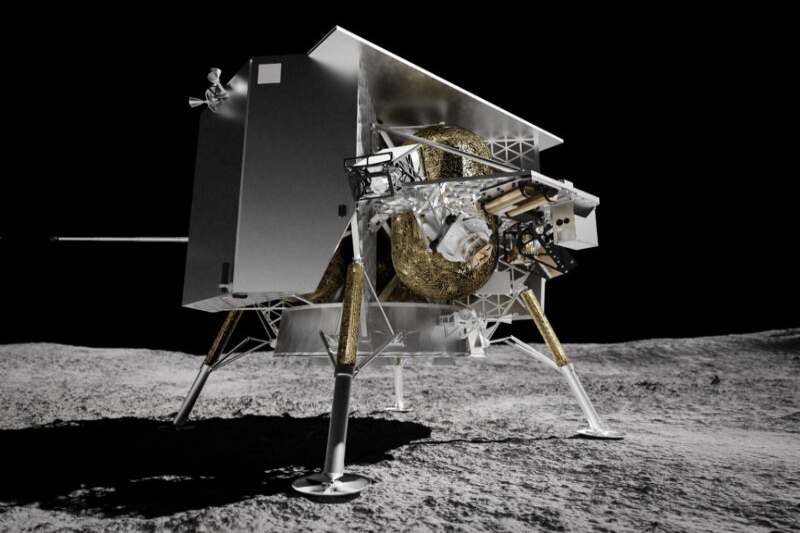
Ready for launch in January is the Peregrine lunar lander
The first lunar lander developed by Astrobotic is prepared for launch in early January, which would enable a landing on the moon in late February.
The Pittsburgh-based company declared on December 19 that all pre-launch integration tasks for its Peregrine lunar lander, which included refueling and mating with the payload adapter for United Launch Alliance’s Vulcan Centaur rocket, had been completed. That arranged for a launch attempt from Cape Canaveral, Florida, as early as January 8, in addition to the rocket’s own preparations.
Peregrine was supposed to be launched this month by Astrobotic, with a launch window of December 24–26 to allow for a landing attempt on January 25. But ULA had to delay the launch in order to finish a wet dress rehearsal that had been cut short in early December due to issues with ground systems. On December 14, ULA announced that the dress rehearsal was over and that the launch date was set for January 8.
Twenty payloads from the government and commercial sectors are being carried by Peregrine, five of which are being carried by NASA as part of its Commercial Lunar Payload Services (CLPS) program. The non-NASA payloads include commemorative and memorial payloads from businesses and organizations, as well as a small lunar rover created by Carnegie Mellon University and a series of even smaller rovers from the Mexican Space Agency.
Earlier this year, five more NASA instruments that were first installed on Peregrine were removed from the lander. At a Nov. 29 briefing, NASA CLPS program manager Chris Culbert stated that the choice was based on how well the lander performed and the descent engines that were available.
“Rather than delay this mission further to wait on additional engine development, we worked with Astrobotic to agree on getting the most important payloads delivered as early as possible,” he said. “We did jointly agree to demanifest a handful of payloads from the first mission to enable that first mission to be more likely to succeed.” Those payloads will be flown on later CLPS missions.
“If you’ve been following the lunar industry, you understand landing on the Moon’s surface is incredibly difficult. With that said, our team has continuously surpassed expectations and demonstrated incredible ingenuity” throughout the lander’s development, said John Thornton, chief executive of Astrobotic, in a statement. “We are ready for launch, and for landing.”
According to Astrobotic, a launch during the window that opens on January 8 would prepare a landing on February 23. The spacecraft will enter lunar orbit and lower its apolune, or high point in orbit, from 9,000 kilometers to 100 kilometers, instead of landing directly on the lunar surface. At the Nov. 29 briefing, Thornton stated, “The majority of the time between launch and landing is waiting for the local lighting to be correct.”
In other words, Peregrine might launch before any other CLPS mission, but it might not land first. Between January 12 and 16, Intuitive Machines intends to launch its IM-1 lunar lander mission on a SpaceX Falcon 9. That mission will approach the moon more directly, allowing for a landing on either January 19 or 21.
IM-1 preparations are still on schedule, according to Intuitive Machines, but there may be a launch delay. Launch Complex 39A at Kennedy Space Center, the only SpaceX pad at Cape Canaveral equipped to supply liquid oxygen and methane propellants to the lander just prior to launch, is where the launch must occur.
LC-39A, on the other hand, is currently configured to assist with the Falcon Heavy launch of the military X-37B spacecraft, whose launch date has been pushed back to no earlier than December 28 due to launch vehicle problems. The pad reconfiguration process for Falcon 9 launches takes about three weeks, so it might not be ready in time to support the IM-1 launch before the launch window closes in January.
As blockchain continues to shape new frontiers across industries, few sectors are as ripe for… Read More
One of the greatest challenges in cryptocurrency is accessibility. With confusing user interfaces, complicated processes,… Read More
Sports Journalist Mazen Saif revealed that the film "I Am Al-Ittihad" is currently showing in… Read More
The cryptocurrency landscape is evolving rapidly, and with it, investors are searching for the next… Read More
Photography is more than just capturing images; it is a form of storytelling that transcends… Read More
The cryptocurrency market is evolving rapidly, and Nexaglobal is at the forefront of this transformation… Read More